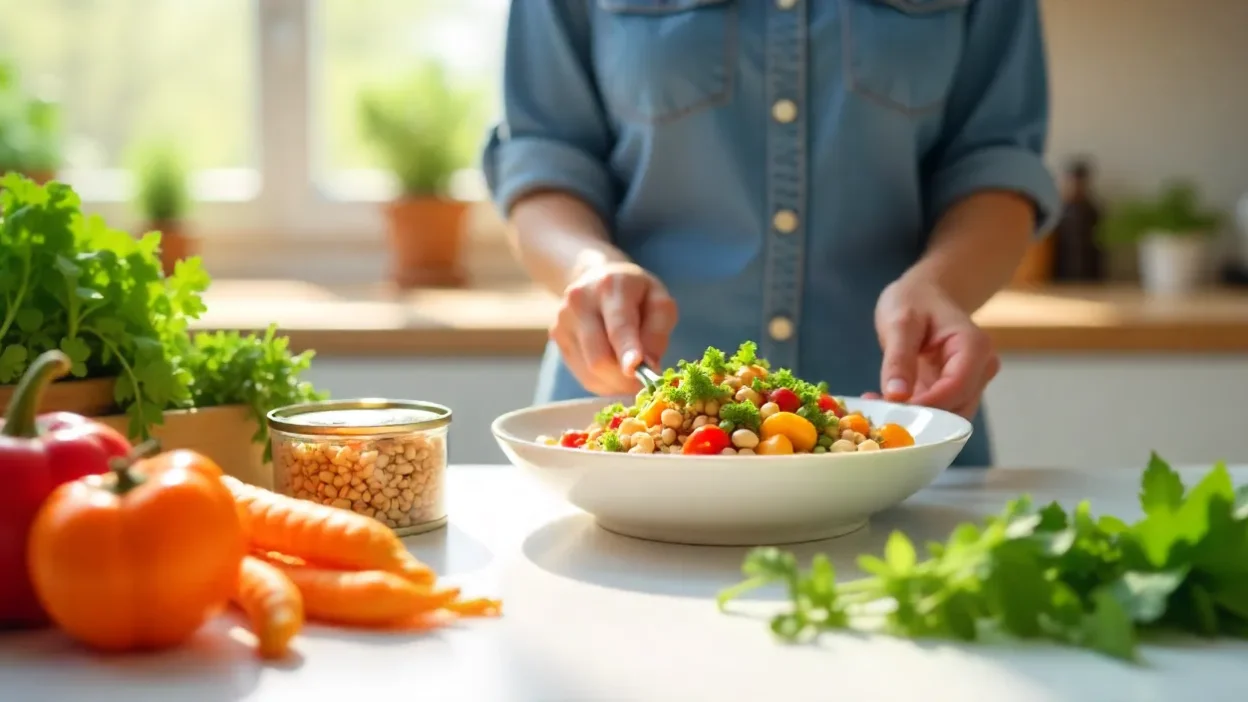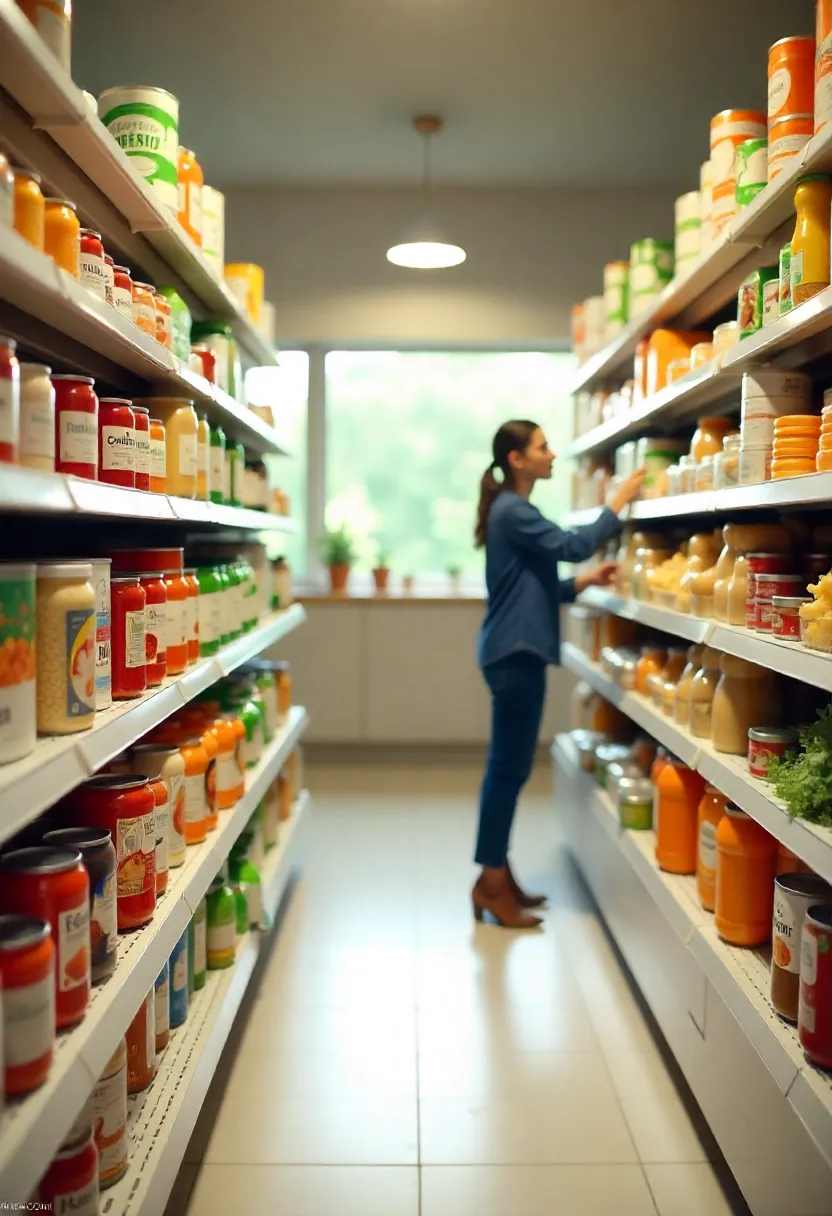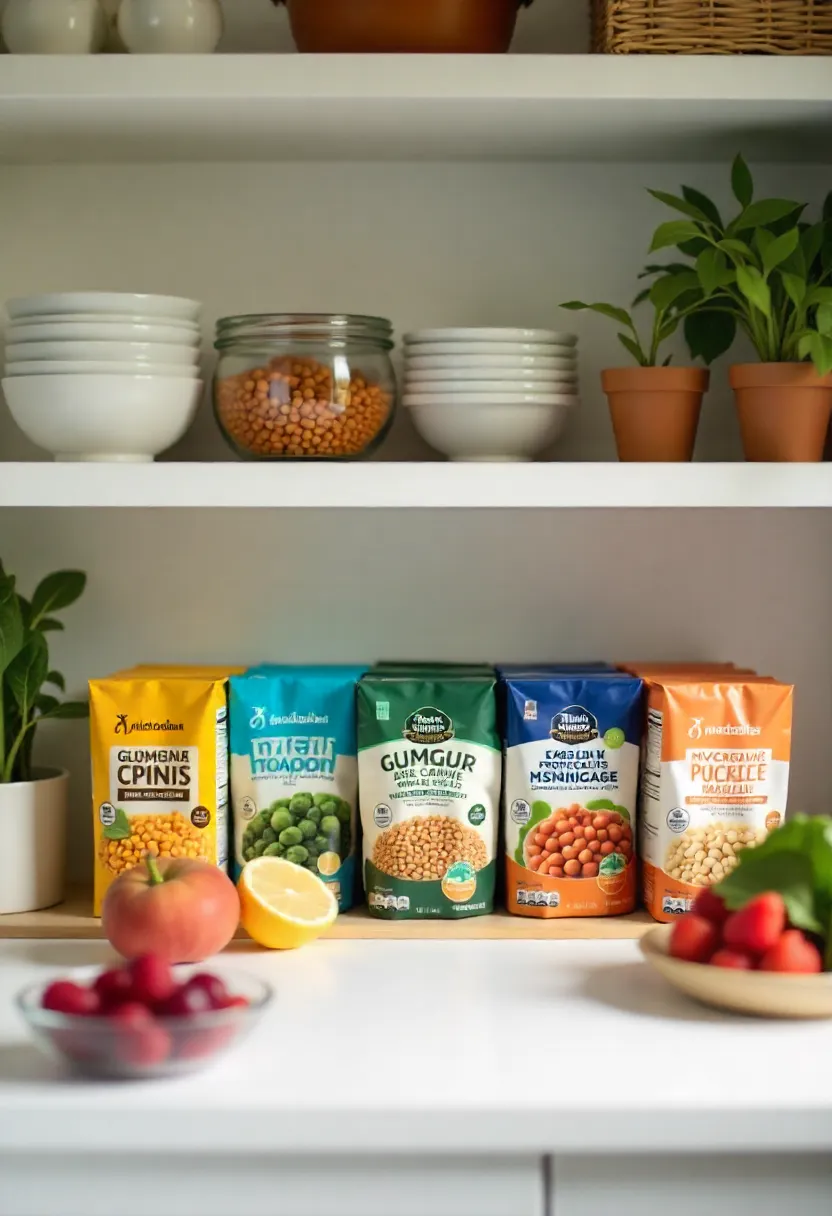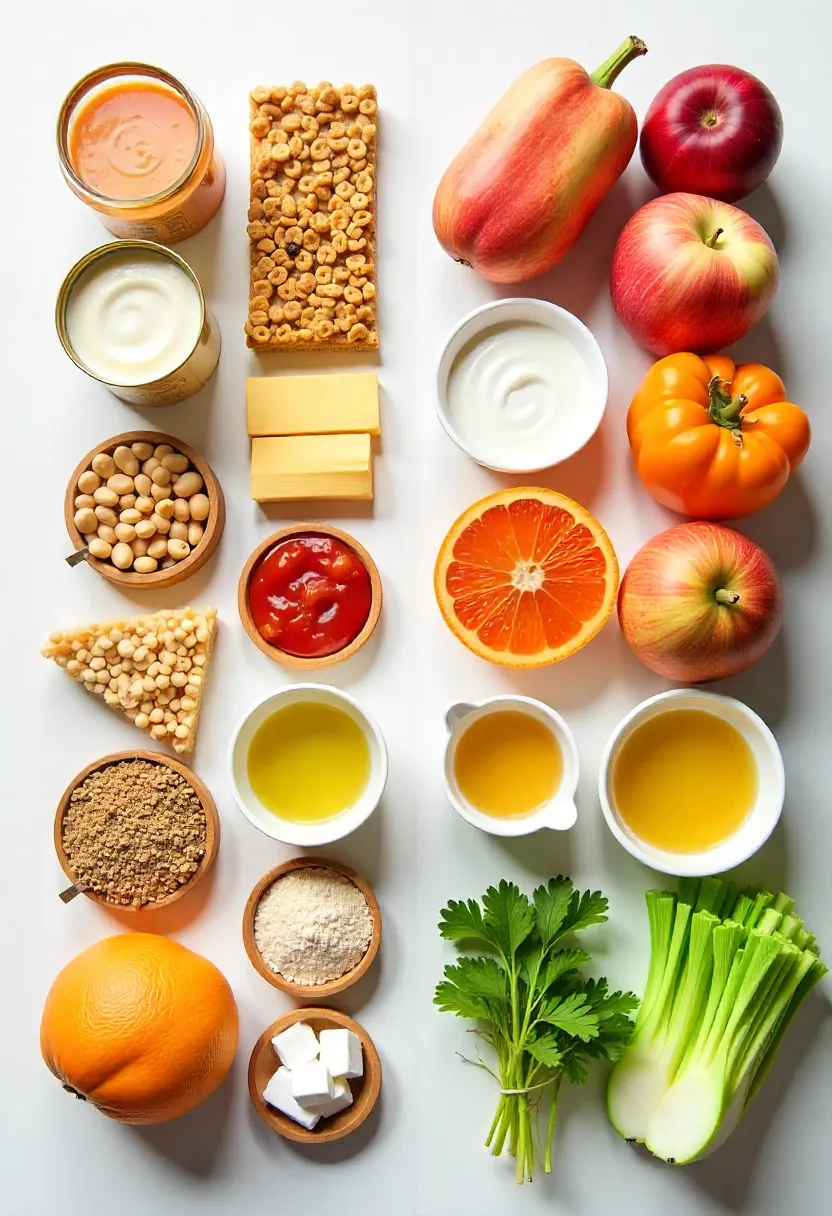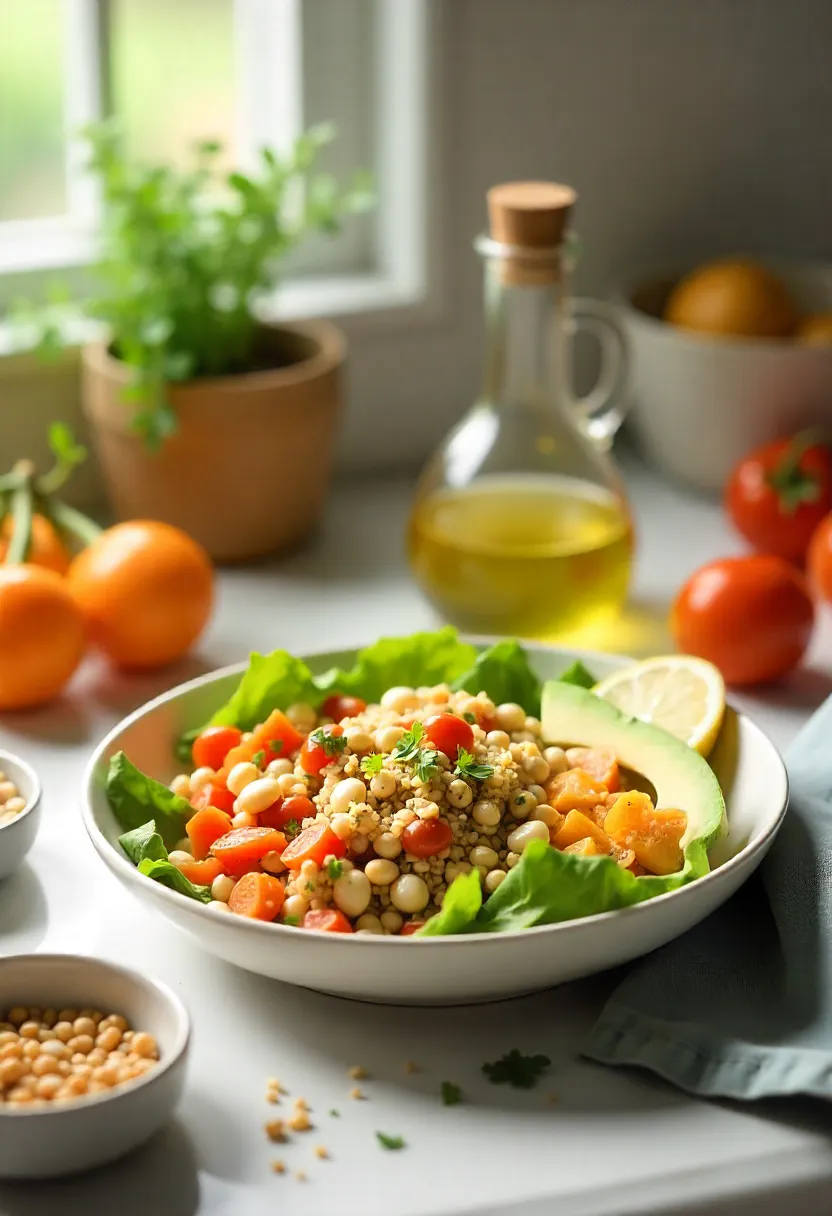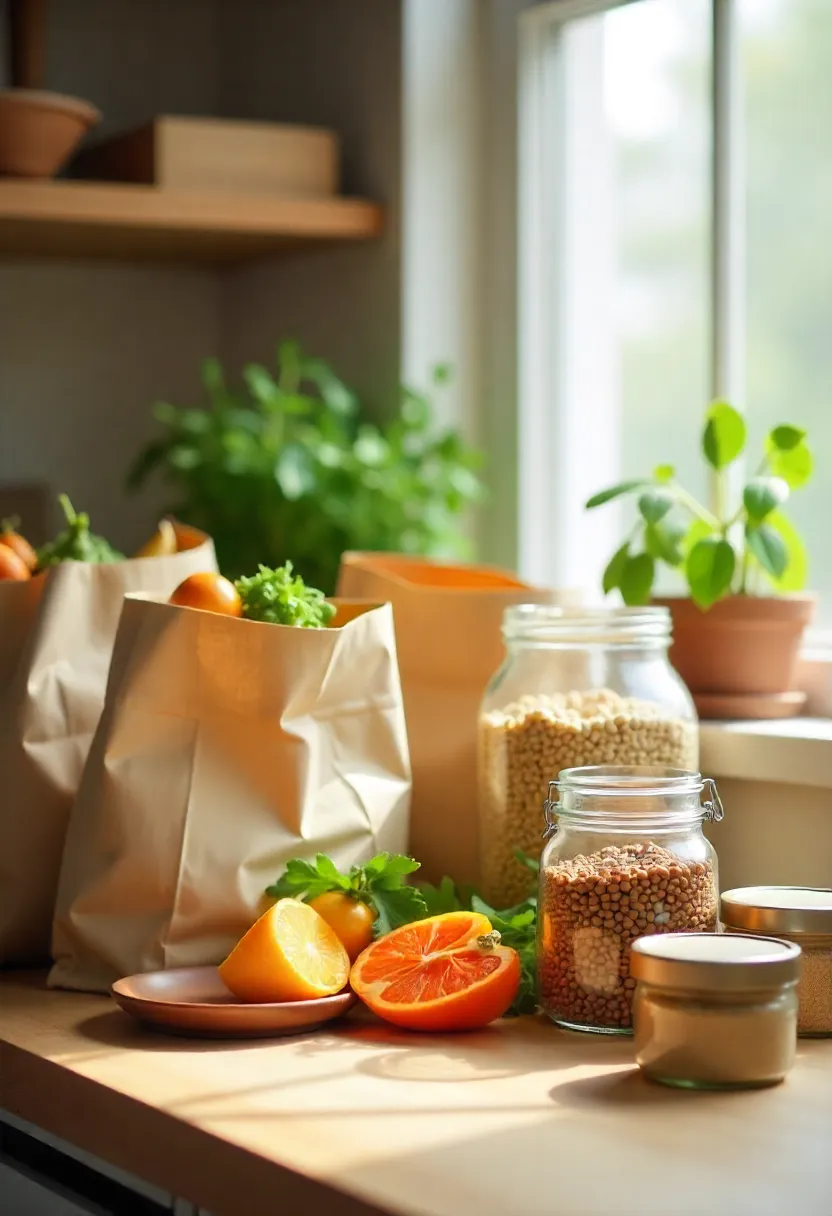Contents
For years, “convenience food” has been blamed for poor diets — salty ready meals, sugary snacks, and ultra-processed junk filling supermarket shelves.
But times have changed. Today, convenience doesn’t have to mean compromise.
🛒 From frozen vegetables to microwave-ready grains, and from tinned beans to pre-cooked lentils, modern convenience foods can actually support a healthy lifestyle — when you know what to look for.
🕒 Why Convenience Matters
Let’s face it: most of us are juggling work, family, and everything in between.
Cooking from scratch every night sounds ideal, but in reality? It’s not always possible.
That’s where smart shortcuts come in.
Healthy convenience foods can help you:
- eat balanced meals even on your busiest days,
- reduce takeout or impulsive snacking,
- and save money and food waste by keeping staples ready to go.
“Convenience doesn’t have to mean unhealthy — it just means making smart, efficient choices.” 🌿
🥦 The New Generation of Ready-Made Foods
The food industry has caught up with modern lifestyles.
We now have access to ready meals made with whole grains, lean proteins, and fresh vegetables, plus frozen or shelf-stable ingredients that retain nutrients almost as well as fresh ones.
💡 Fun fact: Flash-freezing locks in vitamins faster than some “fresh” produce that’s been sitting in storage or on transport for days.
So, instead of thinking of convenience as the enemy of health — it’s time to think of it as your ally in building better eating habits.
🍽️ What You’ll Learn in This Guide
In this article, we’ll explore:
✅ which convenience foods are genuinely healthy,
⚠️ which ones to watch out for,
💡 and how to combine quick ingredients into balanced, nourishing meals that fit your real life.
“Healthy eating doesn’t have to be slow — it just has to be smart.” 🕒🥗
The Rise of Smart Convenience: Why Time-Saving Doesn’t Have to Mean Unhealthy 🚀
Not long ago, “convenience food” meant microwave dinners loaded with salt, fat, and additives — the kind that made nutritionists cringe.
But the world — and our food choices — have evolved.
Today’s busy lifestyles have inspired a new generation of smart, health-focused convenience foods, designed for people who want nourishment and speed, not guilt.
🥦 Convenience 2.0 — Healthier Than Ever
From supermarkets to meal delivery apps, brands now cater to a more mindful audience.
Shoppers are reading labels, looking for protein, fiber, and plant-based ingredients — and companies have responded.
You can now find:
✅ Pre-cooked whole grains like quinoa or brown rice in steam pouches.
✅ Frozen vegetables flash-frozen at peak ripeness.
✅ Tinned beans and lentils with nothing but water and salt.
✅ Healthy ready meals with real ingredients and balanced nutrition.
These foods don’t just save time — they help people stay consistent with healthy eating goals.
“The smartest convenience foods are the ones that make healthy eating effortless.” 💡
🍎 Technology Meets Nutrition
Advances in freezing, vacuum sealing, and packaging have made it possible to preserve nutrients almost perfectly — without artificial additives.
💡 For example:
- Flash freezing retains vitamin C and antioxidants.
- Vacuum-sealed grains and proteins prevent oxidation and flavor loss.
- Cold-pressed or pasteurized juices extend shelf life without chemicals.
The result? Quick, accessible options that rival homemade meals in quality — perfect for those days when time is short but health still matters.
🌍 Convenience Meets Consciousness
It’s not just about health — it’s about values.
Modern consumers care about sustainability, food waste, and clean labels.
That’s why many healthy convenience brands now:
🌱 use recyclable or compostable packaging,
🥣 reduce food waste with portion control,
🐟 offer traceable, responsibly sourced ingredients.
Healthy convenience has become part of a bigger movement — one that blends personal wellness with planetary responsibility. 🌎
💚 The Takeaway
Convenience isn’t the enemy of healthy eating anymore — ignorance is.
The key is learning how to recognize nutritious shortcuts and avoid the truly ultra-processed stuff pretending to be “healthy.”
Top Healthy Convenience Foods to Keep on Hand 🥫🥦
When your schedule’s packed and your energy’s low, the right convenience foods can save both your time and your health.
Think of them as your nutrition safety net — quick, reliable ingredients that help you build balanced meals in minutes.
Here’s your go-to list of healthy convenience staples to stock up on 👇
🧊 1. Frozen Vegetables and Fruit
Frozen produce often gets a bad reputation, but here’s the truth: it’s just as nutritious as fresh — sometimes even more.
Why? Because it’s flash-frozen at peak ripeness, locking in vitamins and antioxidants.
💡 How to use:
- Toss frozen broccoli, peas, or spinach into stir-fries, curries, or pasta.
- Blend frozen berries into smoothies or use them to top yogurt or porridge.
✅ Best picks: Plain, unsalted, and unsweetened varieties — skip the sauces or added sugar.
“Frozen doesn’t mean fake — it means fresh, preserved smartly.” ❄️
🥫 2. Tinned Beans, Lentils & Chickpeas
Canned pulses are nutrition gold: packed with plant-based protein, fiber, and iron — no soaking or long cooking needed.
💡 How to use:
- Add chickpeas to salads or roasted veggies.
- Blend beans into dips, soups, or wraps for instant protein.
- Combine lentils with rice or quinoa for a filling base.
✅ Best picks: Cans labeled “in water” or “no added salt.”
🍚 3. Pre-Cooked Whole Grains
Microwave pouches of brown rice, quinoa, or barley make whole grains easier than ever.
They’re ready in 2 minutes and pair well with almost anything.
💡 How to use:
- Combine with canned beans and veggies for a 10-minute meal.
- Serve as a side for stir-fries, stews, or grilled fish.
✅ Best picks: 100% whole grains, minimal oil, no artificial flavorings.
“Whole grains don’t need to take all day — just a good pouch and 2 minutes.” 🍽️
🐟 4. Canned Fish (Tuna, Salmon, or Sardines)
Tinned fish is one of the most underrated health hacks — full of omega-3s, protein, and key minerals.
It’s shelf-stable, affordable, and incredibly versatile.
💡 How to use:
- Mix tuna or salmon with Greek yogurt, lemon, and herbs for a quick sandwich filling.
- Add sardines to toast or pasta for a Mediterranean twist.
✅ Best picks: Fish in water or olive oil — skip the sugary or creamy sauces.
🥗 5. Ready-to-Eat Salads & Veggie Packs
Pre-washed greens, shredded veggies, or mixed salad bags make it easy to add freshness to any meal — no chopping required.
💡 How to use:
- Toss with canned beans and olive oil for a 5-minute lunch.
- Add pre-grilled chicken or tofu for instant protein.
✅ Best picks: Simple mixes without dressing — you can add your own healthy fats and seasonings.
🧀 6. Healthy Protein & Dairy Options
Pre-cooked chicken strips, boiled eggs, or low-fat Greek yogurt are lifesavers for quick, balanced snacks.
💡 How to use:
- Pair yogurt with fruit and oats for breakfast.
- Add protein packs to salads or wraps for an energy boost.
✅ Best picks: Unsweetened yogurts, low-sodium meats, minimally processed cheese.
🍅 7. Sauces, Seasonings & Pantry Staples
Healthy doesn’t have to be bland — the right seasonings turn basics into delicious meals.
💡 Keep on hand:
- Tomato passata, olive oil, herbs, garlic, canned tomatoes, and tahini.
- A few versatile sauces like pesto or soy sauce (use sparingly for salt).
“Your pantry is your secret weapon — keep it simple, colorful, and versatile.” 🌈
💚 The Takeaway
Healthy convenience foods don’t replace home cooking — they support it.
Stock your freezer, pantry, and fridge with smart staples, and you’ll always have the foundation for quick, nourishing meals.
“Healthy eating isn’t about effort — it’s about preparation.” 🥫✨
What to Watch Out For: Hidden Salt, Sugar & Fats ⚠️
Not all “healthy” convenience foods are what they claim to be.
Marketers are clever — they know you’re looking for words like “natural,” “light,” “protein,” or “organic.”
But labels can be deceiving, and some ready-made products still hide high levels of salt, sugar, or unhealthy fats.
Here’s how to tell the good from the not-so-good. 👇
🧂 1. Salt: The Silent Flavor Booster
Salt makes food taste great — but too much raises blood pressure and increases heart disease risk.
Ready meals, soups, and sauces are often loaded with sodium to boost flavor and shelf life.
💡 Fix it:
- Check the per 100g line on the nutrition label.
- Low salt = 0.3g or less
- High salt = 1.5g or more
- Choose reduced-salt options and add flavor with herbs, lemon, or spices instead.
- Rinse canned beans or vegetables to remove excess sodium.
“The healthiest meals don’t come from a salt shaker — they come from fresh seasoning.” 🌿
🍬 2. Sugar: The Sneaky Sweetener
Sugar hides everywhere — not just in desserts.
Even “healthy” snacks, granola bars, yogurts, and sauces can pack 5+ teaspoons of added sugar per serving.
💡 Fix it:
- Look for less than 5g of sugar per 100g.
- Watch for hidden sugar names like maltose, syrup, fruit concentrate, or dextrin.
- Choose plain yogurts or unsweetened nut milks — add fruit or cinnamon for sweetness.
✅ Pro tip: If sugar is listed in the first 3 ingredients — it’s too much.
“Sugar wears many disguises — always read the fine print.” 🍫👀
🧈 3. Fats: The Good, the Bad & the Hidden
Not all fats are villains — but trans fats and hydrogenated oils should be avoided.
Some convenience foods use them to extend shelf life, especially baked goods, processed snacks, and creamy sauces.
💡 Fix it:
- Choose products with olive oil, avocado oil, or nut oils instead of “vegetable fat.”
- Look for labels saying “no hydrogenated oils.”
- Combine healthy fats (nuts, seeds, oily fish) with lean protein and fiber for balance.
“Healthy fats fuel your body — fake fats slow it down.” 🥑
📊 4. Misleading Labels to Watch
Food packaging can be more about marketing than nutrition.
Here are a few “buzzwords” that don’t always mean healthy:
| Label Claim | What It Might Really Mean |
|---|---|
| “Low-fat” | Often high in sugar or additives to replace flavor |
| “High-protein” | Can still be ultra-processed or high in salt |
| “Organic” | Refers to ingredients’ source, not nutrient content |
| “Natural” | No clear legal definition — could still be processed |
| “Light” | Often means reduced calories, but not necessarily balanced |
💡 Always read the ingredients list — it tells the truth marketing can’t hide.
💚 The Takeaway
Healthy eating is about informed choices, not perfect ones.
Learn to read labels, spot the marketing traps, and your shopping cart will start working for your health — not against it.
“Nutrition labels don’t lie — but marketing often does.” 📦✨
How to Build Balanced Meals with Convenience Foods 🍲
Healthy eating isn’t about fancy recipes — it’s about balance.
With a few smart staples, you can build nutritious, satisfying meals in under 15 minutes — no chef skills required.
The formula?
Protein + Fiber + Healthy Fats + Color = Balanced Energy 🌈
🥦 Step 1: Start with a Base of Whole Grains or Veggies
Use ready-to-eat grains like brown rice, quinoa, or bulgur, or go low-carb with a bed of leafy greens, cauliflower rice, or spiralized veggies.
💡 Examples:
- Brown rice pouch + frozen peas + olive oil + lemon.
- Mixed salad base + roasted veggies + seeds.
✅ Tip: Add color! The more variety you see, the more nutrients you get.
🥫 Step 2: Add Protein for Sustained Energy
Canned beans, lentils, or tinned fish are quick wins.
Or use pre-cooked chicken, tofu, or eggs for instant balance.
💡 Examples:
- Lentils + tomato passata + herbs = 10-minute lentil stew.
- Tuna + sweetcorn + Greek yogurt = quick lunch wrap.
✅ Tip: Aim for a palm-sized serving of protein per meal.
🥑 Step 3: Include Healthy Fats
Fats keep you full, support brain health, and make meals taste great.
Add avocado, olive oil, nuts, or seeds — small portions go a long way.
💡 Examples:
- Sprinkle pumpkin seeds on soups or salads.
- Drizzle olive oil or tahini over grain bowls.
“Healthy fats don’t make you fat — they make you fueled.” 💪
🍅 Step 4: Bring It Together with Flavor
This is where healthy convenience foods shine — minimal effort, maximum taste.
Add pre-made sauces like tomato passata, pesto, or a dash of soy sauce for flavor depth.
💡 Quick flavor ideas:
- Mediterranean: olive oil, basil, lemon, garlic.
- Asian-inspired: soy sauce, sesame, ginger, lime.
- Mexican: avocado, beans, chili flakes, coriander.
✅ Keep sodium low and flavor high with herbs and spices.
🕒 Step 5: Think “15-Minute Assembly,” Not Cooking
Healthy meals don’t have to be cooked from scratch — they can be assembled.
Use what you have, mix and match, and don’t stress about perfection.
💡 Example meal ideas:
🥗 Quinoa + chickpeas + spinach + olive oil + feta.
🍝 Wholegrain pasta + canned tomatoes + tuna + frozen veggies.
🌯 Tortilla wrap + ready chicken + hummus + salad mix.
“If it’s colorful, balanced, and makes you feel good — it’s healthy enough.” 🌿
💚 The Takeaway
Convenience foods can be your best friend when used wisely.
Think of them not as shortcuts, but as smart tools for building balanced meals that fit real life.
“Healthy eating isn’t about time — it’s about intention.” 🕒🍴
Budget & Sustainability Tips 💰🌍
Healthy eating doesn’t have to be expensive — and convenience doesn’t have to harm the planet.
With a little strategy, you can save time, money, and resources while eating well and reducing waste. 🌿
Here’s how to make your shopping basket work smarter for both your wallet and the world.
🛒 1. Mix Fresh with Shelf-Stable
The best budget-friendly meals use a hybrid strategy: fresh foods for flavor and texture, and long-lasting items for stability.
💡 Example combos:
- Fresh spinach + canned beans + frozen quinoa.
- Fresh herbs + tinned tomatoes + wholegrain pasta.
- Frozen berries + plain yogurt for quick breakfasts.
✅ Tip: Use fresh ingredients early in the week and frozen or canned toward the end — less waste, more value.
“Smart cooks use the fridge, freezer, and pantry like a team.” 🥫🥦
💵 2. Buy in Bulk — But Store Smart
Buying in larger quantities saves money and reduces packaging waste — as long as you store it properly.
💡 Smart bulk buys:
- Whole grains, nuts, seeds, and oats.
- Frozen mixed veggies and fruits.
- Long-life plant milks, tinned fish, and beans.
✅ Use glass jars or reusable containers to keep items fresh and visible — if you can see it, you’ll use it.
🌱 3. Choose Eco-Conscious Brands
Look for companies that prioritize sustainability — recyclable packaging, fair sourcing, and reduced plastic use.
💡 Eco check:
- “Recyclable” or “compostable” packaging logos.
- Certified sustainable seafood (MSC).
- Locally sourced or minimally processed ingredients.
✅ Small swaps matter — choosing better brands shifts the market toward responsibility.
♻️ 4. Reduce Food Waste with Convenience Items
Convenience foods can actually prevent food waste by offering perfect portions and longer shelf life.
💡 Try this:
- Use frozen produce to avoid spoilage.
- Store leftovers in glass containers for easy reheating.
- Turn “extras” into new meals — leftover grains → stir-fry, roasted veggies → soup.
“Every ingredient deserves a second life.” 🍲
📦 5. Skip Single-Use Plastics & Over-Packaging
Pre-packed snacks and mini servings often cost more and create more waste.
Instead, buy larger packs and divide them into your own reusable containers.
💡 Fix it:
- Use beeswax wraps or glass jars instead of cling film.
- Make your own snack boxes with nuts, fruit, and yogurt.
✅ It’s cheaper, cleaner, and better for the planet. 🌎
💚 The Takeaway
Healthy convenience doesn’t have to clash with your budget or the environment.
When you plan smart, buy thoughtfully, and use what you have, you’ll eat better and live more sustainably.
“The healthiest choices are often the most sustainable ones, too.” 🌍💛
Conclusion: Balance, Not Perfection 🌿✨
Healthy eating isn’t about cooking everything from scratch or avoiding every processed product.
It’s about finding balance — using convenience wisely, choosing real ingredients when you can, and building meals that nourish both your body and your lifestyle.
The truth is, life is busy. And that’s okay.
Convenience foods don’t make you “lazy” — they make you realistic. What matters most is how you use them.
🍴 The Modern Way to Eat Well
In 2025, health isn’t about restriction — it’s about flexibility.
It’s about stocking your kitchen with staples that make good choices easier, faster, and more enjoyable.
💡 Because when healthy food is convenient, it becomes consistent.
So yes — grab that pouch of quinoa, that tin of beans, or that frozen spinach.
They’re not cheats; they’re tools that support your health, your time, and your sanity. 🌿
💚 Final Thought
You don’t need perfection — just progress.
Every small decision, every smart swap, every balanced meal adds up to a healthier, happier, and more sustainable you.
“The goal isn’t to do everything perfectly — it’s to make healthy the easiest choice.” 🌞✨

